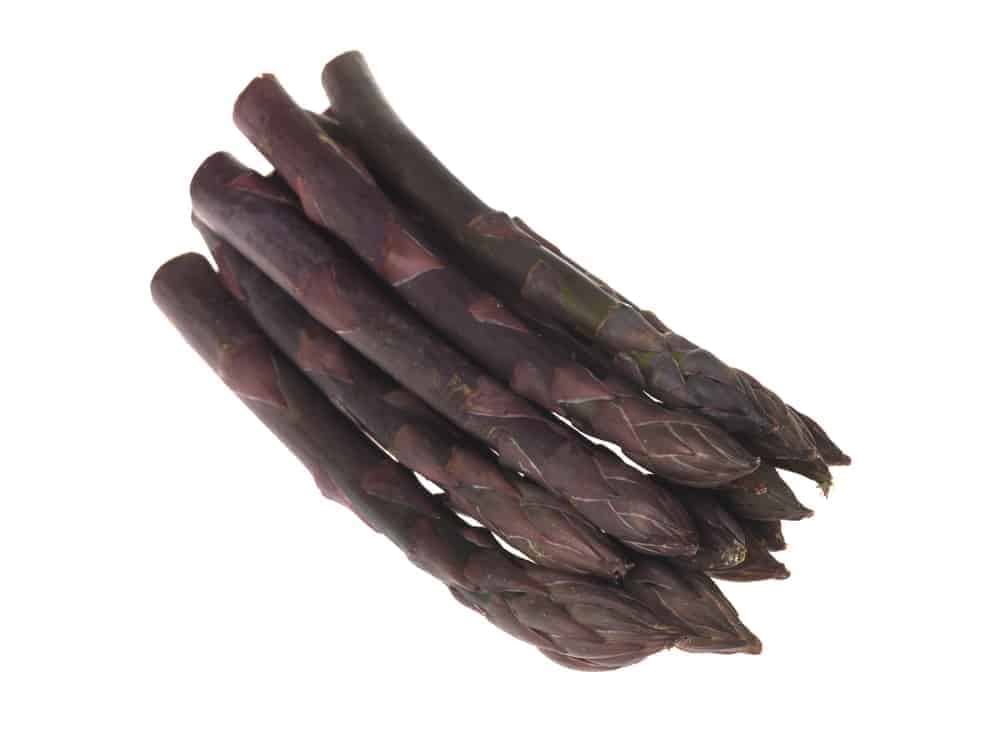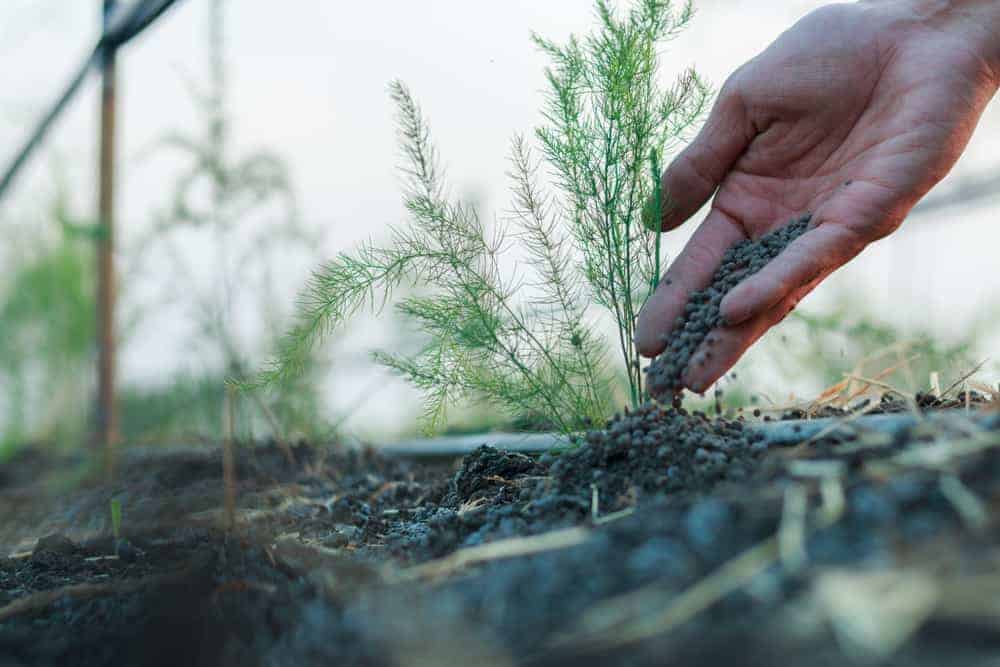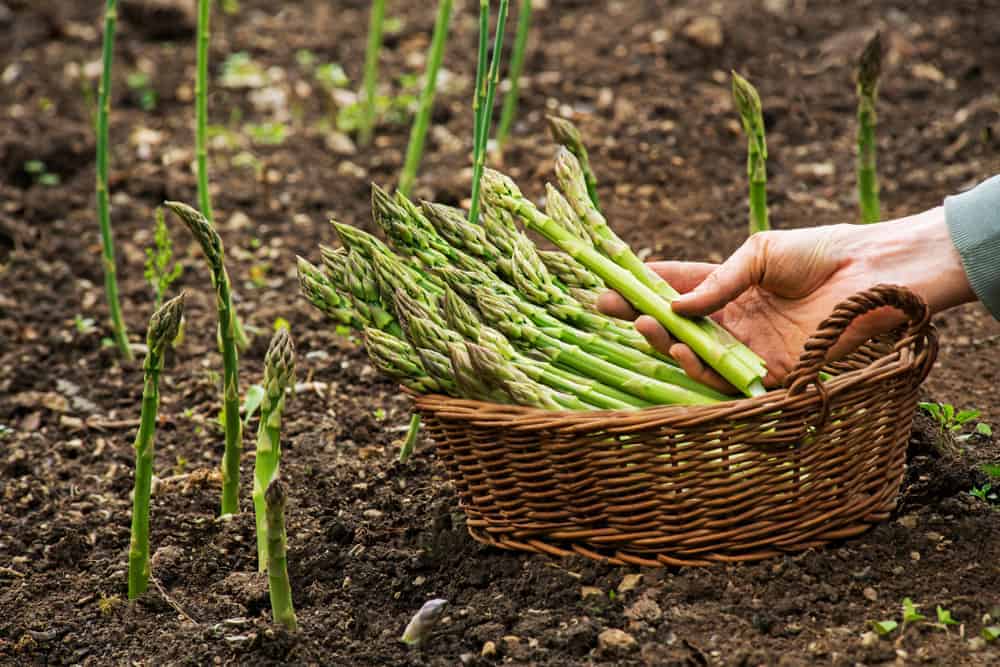Asparagus is a widespread plant in the US, and you can grow it in all regions of the country except in areas with extreme summer heat (the Gulf Coast and Florida).
If you provide a sandy loam soil, excellent drainage, and adequate soil moisture, your crop will thrive. The best way to minimize the danger of soil-borne diseases is to plant asparagus in a part of your garden you have never cultivated these veggies before.
What You Should Know About Asparagus

Your asparagus will require the soil with a pH range of 6.5 to 7. If you need to raise the pH of your ground, just add some pulverized limestone approximately six months before planting this crop. On the other hand, if the soil pH is too high, you may correct it by applying sulfur.
Asparagus is one of the first plants you can plant in early spring. As a perennial vegetable, it will start with real production after two to three years, and you can expect to spot the first greenery almost immediately after winter. The same plant will be productive for more than twenty years, producing 0.5 pounds (230 g) of spears per foot of one row.
Asparagus is a dioecious plant. That means that they have both sexes (male and female plants). You can clearly notice red berries which are form on female ferns in the fall with about 19,200 tiny seeds. There are up to 1 pound (450 g) of them inside the berries. If you decide to sow those seeds, it will take three years before the first harvesting.
On the other hand, male plants don’t produce berries. Therefore, they are more productive than female ones and have stronger root systems as well. To get an excellent yield, you just need to find the right spot for male asparagus in your garden and wait patiently to collect them.
How to Choose the Best Asparagus
For years, most of the well-known varieties on the market were female. They spread out, overloaded beds, and decreased the quality of the plants since they needed extra energy for seeds production.
Nowadays, we have new, male varieties available. That means these plants will produce a massive spear, and you will get higher yielding. Choose the particular type of this crop carefully since it is the long-living plant, and you will stick with it for years.
If you are an extravagant person, you may wish to choose two unusual varieties for your garden:
Asparagus with white stalks

You can grow those plants from any type you select by using the so-called blanching method. The secret is in restricting exposure to sunlight.
Asparagus with purple spears

You can find both male and female plants in this color. They are unique, well-known for a sweet taste and tender texture. The most popular are:
- Purple passion asparagus
- Sweet purple asparagus
If you prefer traditional varieties, there are a few highly productive ones available on the market.
Asparagus varieties |
|||
|
Male |
Female |
||
|
Jersey giant asparagus |
This early crop is one of the oldest developed varieties. It yields huge, thick spears and prefers cold weather |
Mary Washington asparagus
|
Even though it is one of the oldest varieties grown in the US, it is still a favorite crop with high yields |
|
Jersey supreme asparagus |
This great producer prefers cold weather and grows in sandy soil |
Precoce d’argenteuil |
It is an old traditional Europe variety which stalks are perfect for blanching |
|
Jersey Knight asparagus |
It is a pretty popular choice since it tolerates warmer climates and grows on a wide variability of soils, even clay | ||
|
Jersey king asparagus |
This plant can be widely variable, and you can grow it in warm climates | ||
Growing Asparagus in Your Garden
Before you decide to plant asparagus, you need to be prepared well and make a detailed plan. To get a good yield, you should find a permanent place for these vegetables and be patient. Only that way, you will be satisfied with the results.
The soil preparation
Before planting, you need to prepare the soil for your future crop. As for asparagus, it prefers sandy and well-draining soil with as much sun as possible. Keep in mind that too wet soil causes rotting the roots.
Also, it is essential to keep the roots of those plants at least 12 to 18 inches (30.5 – 46 cm) away from sidewalks or fences. Asparaguses will grow tall, and they may shade other herbs in the garden. Therefore, try to plant them on the north side of your yard. If you like that way, you can also use rows planted with this crop as a hedge plant.
Planting

It’s up to you to decide if you want to start asparagus from seeds or crowns (year-old plants). Your decision will depend on the time when you want to harvest your crop.
As I have already mentioned, asparagus has male and female plants. Since only the male ones produce the edible spears, you should be careful while picking out seeds/crowns for planting.
-
Planting asparagus from the seeds

It is an attractive option if you are a patient gardener. If you choose to plant this veggie from the seeds, you will have a more comprehensive selection of varieties at your disposal.
Start planting after the temperature of the ground reaches 60 F (15.5 C). Sow the seeds in a row approximately 2 inches (5 cm) apart and 0.5 inches (1.3 cm) deep and let them grow for about a year. Then transplant your crop in the permanent part of your garden.
-
Planting asparagus from the crowns

If you choose this option, you need to purchase a year old crowns. That way, you will wait for a decent harvest one year less. The process is quite simple. Just dig a trench about 1 foot (30.5 cm) wide and approximately 6 to10 inches (15 – 25.5 cm) deep. Mix the soil with rock phosphate for better vigor.
Place your crowns about 1 foot (30.5 cm) apart, and take care that their tops are at least 6 to 8 inches (15 – 20 cm) below the trench’s edge. Spread 2 inches (5 cm) of compost above all and add the soil gradually, following the growth of plants. The deeper buried crowns are usually more productive.
How to Care Asparagus in Your Garden
1. Light

Asparagus plants prefer growing in full sun. Without enough daily sunlight, you will get weak veggies with thin spears which are prone to diseases.
2. Water

As soon as you plant asparagus crowns, you should water them deeply. After that, keep watering your young plants regularly to help them establish. After a while, they will need to be watered sporadically, which will primarily depend on dry and hot periods.
3. Temperature

Your asparagus need temperatures of 70 to 85 F (21 – 29.5 C) during the day and about 60 to 70 F (15.5 – 21 C) overnight for healthy and lush growth. When temperatures are above 85 F (29.5 C) and less than 55 F (13 C), you can expect reduced growth of your crop.
To begin to grow in the spring, young plants require the temperature of the soil of at least 50 F (10 C). Keep in mind that your asparagus is sensitive to frost. If frost appears after the shoots start growing, it will cause discoloration of plants.
4. Fertilizer

After you water your young asparagus, you should add some mulch over rows with a thick layer of straw on the top. That way, you will protect plants from cold weather, reduce weeds growth, add some extra nutrients to the soil, and keep it moist.
During the first three years of growth, you should add a balanced fertilizer in the ground, preferably in early spring. From the fourth year, there is no need to add any fertilizer until finishing harvest.
5. Weeding

It is essential to keep your plants free of weeds. Since these veggies don’t have foliage to shade the soil around them, it is straightforward for weeds to thrive unhindered.
Therefore, you should cultivate the area in early spring and don’t give up weeding throughout the season. Once asparagus spears are plenty tall, you can stop weeding since their height will overgrow any wild grass.
6. Trellising

If your plants are over 6 feet (180 cm) high, you can choose to leave them that way to spread seeds or to trellis them. The simplest way is to shove stakes in the ground and let plants string around spears so they can’t topple over.
How to Harvest Asparagus

If you decide to start your asparagus from seeds, it will take about three years to get decent yields. During the first harvesting season, cut just a limited amount of spears for ten days. That way, your veggie will build strength, and prepare for higher yields the next year.
In the second season, you can cut plants for two weeks. From the third year, harvest up to six weeks but leave thin spears. Select just those with tightly closed tips. They should be tall about 6 to 8 inches (15 – 20 cm) and at least 0.5 inches (1.3 cm) thick. Cut them close to the surface of the soil.
How to store asparagus

You can’t keep your asparagus for a very long period after harvesting, but they can stay in excellent condition for approximately fifteen days. Brush them off, lightly wash the spears with cold water, and dry them thoroughly to avoid the occurrence of mold.
Put plants in a plastic bag and store them in the refrigerator. The other way is to put the spears in a cup with 1 inch (2.5 cm) of clean water and store them in the fridge for a few days without any reducing in flavor and damaging texture.
Asparagus Pests and Diseases
This perennial plant is mainly resistant, but sometimes it may suffer from some pests and diseases.
The most common pests
- Asparagus beetle

This orange pest attacks asparagus tips and ferns, and eats them while laying eggs. You can get rid of them by using organic sprays. However, the best option is the introduction of their natural predators such as lady beetles and wasps.
- Asparagus miner
That black fly will damage stems and cause red markings on them. To reduce this pest, you should remove foliage in winter or use some organic sprays.
- Japanese beetle

That beetle destroys above-ground foliage of your asparagus. Use pheromone traps, organic sprays, or birds, as their natural predators, to keep them away from your crops.
- Slugs and snails

They feed on the young seedlings. If you notice the telltale slime trail on the soil around your plants, try to save your crops by using eggshell barriers, beer traps, copper tape, or sawdust.
The most common diseases
- Fusarium rot

This fungus attacks root, lower stem, and crowns, and leaves them red and unattractive. Consequently, it will reduce yields.
The only way to prevent this is to ensure adequate watering, avoid the damage of crowns, and select disease-resistant varieties. Also, you can reduce pests by avoiding planting new asparagus at the sites where this veggie has grown in the last eight years.
- Purple spot

It causes brown damage to your asparaguses and purple spots on their stalks. To prevent these fungi disease, you should use organic sprays and burn affected foliage.
- Rust

It affects the foliage and causes the appearance of yellow and brown leaves and their loss. The only way of prevention is to remove and burn affected greenery.

Leave a comment